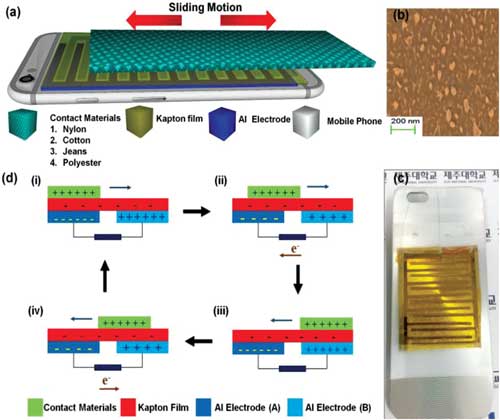| Posted: Jul 06, 2017 | |
Portable energy harvester for self-powered devices |
|
| (Nanowerk Spotlight) Researchers worldwide have begun developing triboelectric nanogenerators (TENGs) for harvesting ambient environmental energy – for instance human walking and ocean waves – and large-scale TENG devices don't seem to be far off. | |
| With a focus on using eco-friendly materials such as fabrics worn in daily life (nylon, jeans, cotton, etc.), researchers now have developed and demonstrated an innovative product for scavenging biomechanical energy. | |
| "The recent requirement for wireless power transfer in gadgets such as mobile phones, MP3 players and other portable devices motivated us to design and develop a self-powered wireless power transfer Smart Mobile Pouch Triboelectric Nanogenerator (SMP-TENG)," Arunkumar Chandrasekhar, a Ph.D. candidate in Prof. Sang-Jae Kim's Nano-Materials & Systems Lab at Jeju National University, South Korea, tells Nanowerk. "In our proposed SMP-TENG, the generation of electricity occurs during interactions between freestanding fabrics and a Kapton film during human movement." | |
| Reporting their findings in Nanoscale ("A smart mobile pouch as a biomechanical energy harvester towards self-powered smart wireless power transfer applications"), first-authored by Chandrasekhar, the team demonstrates a SMP-TENG that can generate electricity from lateral sliding and vertical contact and separation with freestanding fabrics; it also can serve as a self-powered emergency flashlight and self-powered pedometer. | |
| The team's smart mobile pouch is an innovative approach to combining everyday electronic objects, like a smartphone, and the possibility to harvest energy for the operation of these devices from their daily use. In this case, electricity is generated either by by sliding the smartphone in and out of its carrying pouch or by repeated vertical contact and separation. This energy is then transmitted wirelessly to the device via electromagnetic induction. | |
 |
|
| (a) Schematic illustration showing the structural design of the Smart Mobile Pouch Triboelectric Nanogenerator (SMP-TENG) during sliding motion. A top view field emission-scanning electron microscopy (FE-SEM) image of the dielectric barrier discharge (DBD) plasma-treated Kapton film as an active layer. (c) Photograph shows a fabricated SMP-TENG used as a mobile pouch. (d) Schematic diagram of a dielectric-to-dielectric SMP-TENG energy harvesting mechanism during sliding mode operation. (© The Royal Society of Chemistry) (click on image to enlarge) | |
| "The mechanism of the SMP-TENG is based on inductive coupling between electrostatic induction and triboelectrification, which contributes to a flow of electrons between the interdigitated electrodes," Chandrasekhar explains. "This technique works over a short range with low directivity, and at operational frequencies in the range of Hz to MHz. Because this is a near-field wireless power transmission technique, electrical energy is transferred between two coils separated by a short distance." | |
| The team's design upgrades the traditional energy harvesting device into a self-powered wireless power transfer SMP-TENG that can be used to charge a Li-ion battery and light LEDs. | |
| Other competitive features, including a simple fabrication process, low fabrication cost and good electrical performance, indicate that this represents significant progress in the field of self-powered devices. | |
| This study opens up a new approach in the field of commercializing TENG in future smart phones. | |
 By
Michael
Berger
– Michael is author of three books by the Royal Society of Chemistry:
Nano-Society: Pushing the Boundaries of Technology,
Nanotechnology: The Future is Tiny, and
Nanoengineering: The Skills and Tools Making Technology Invisible
Copyright ©
Nanowerk LLC
By
Michael
Berger
– Michael is author of three books by the Royal Society of Chemistry:
Nano-Society: Pushing the Boundaries of Technology,
Nanotechnology: The Future is Tiny, and
Nanoengineering: The Skills and Tools Making Technology Invisible
Copyright ©
Nanowerk LLC
|
|
|
Become a Spotlight guest author! Join our large and growing group of guest contributors. Have you just published a scientific paper or have other exciting developments to share with the nanotechnology community? Here is how to publish on nanowerk.com. |
|
